Have you ever struggled assigning weights in a suitability model or composite index? You are not alone. In ArcGIS Pro version 3.5, this process was made easier with the new Assign Weights by Pairwise Comparison geoprocessing tool.
There are a wide range of models in ArcGIS that solve multicriteria problems addressing a vast array of use cases. This group of models have a common thread, they require the weighting of a series of variables relative to one another. Examples of these models include the following:
- Combining multiple criteria in a bear habitat ModelBuilder model
- Creating a hurricane vulnerability index from a series of variables using the Calculate Composite Index tool in Spatial Statistics
- Ranking candidate sites for a distribution center in Europe using the suitability modeling capability in Business Analyst
- Locating a recycling transfer station with the Suitability Modeler as displayed in the image below

These models all face a similar challenge: how do you set the relative weights for the variables?
Does the following scenario sound familiar? To define the weights, as in the above suitability model, you begin by setting a weight for one criterion. Then you set another, and another. But when seeing the effects of some of the weights that are set, the weights might need to be adjusted. And adjusted and adjusted. Assigning weights as a unit for a series of criteria can be subjective and require some guessing.
To solve this, what you can do is confidently compare the criteria by pairs. For example, you can identify if slope is more important than aspect and by how much. You can now do so using the Assign Weights by Pairwise Comparison tool.
Developed by Saaty (2008), pairwise comparison simplifies complex decisions and provides a systematic way to prioritize or rank the input variables. The Assign Weights by Pairwise Comparison tool calculates the relative weights for the variables from the comparisons of the pairs.
How the tool works
The following image shows the tool with the criteria from the above recycling transfer station suitability model entered as the Input Variables To Compare values.
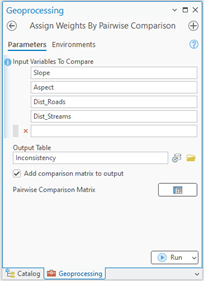
There are three steps when calculating the weights using the pairwise methodology:
- Enter the variables or criteria.
- Identify the pairwise comparisons from which the comparison matrix is created.
- Calculate the weights.
To specify the preference for each pair of variables, open the Define Pairwise Comparison window by clicking the Compare variables and calculate weights button.

The tool automatically creates the pairs from the input variables. The first pair is slope and aspect. In this pair, the slope is significantly more important than aspect, so you move the slider to 5 on the slope side of the pairing. As each slider is moved, the comparison matrix below the sliders is updated.
In the next pairing, slope is only slightly more important than distance from roads, so the slider is moved to 3 on the slope side of the pairing. You continue with the evaluation process by moving the sliders for each pair as demonstrated in the image below.
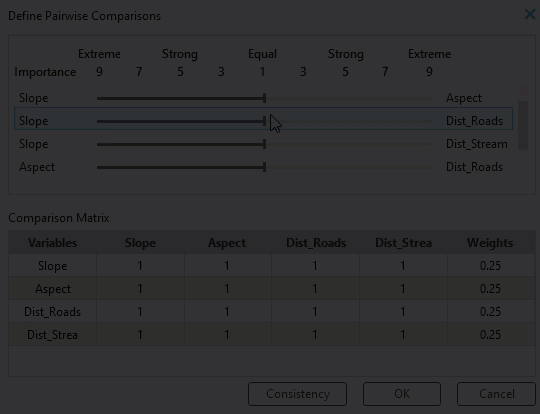
The tool also provides functionality to ensure the pairwise evaluations are consistent. That is, if A is greater than B and B is greater than C; it would be inconsistent to say C is less than A.
To verify the evaluations, click the Consistency button to calculate the consistency ratio.
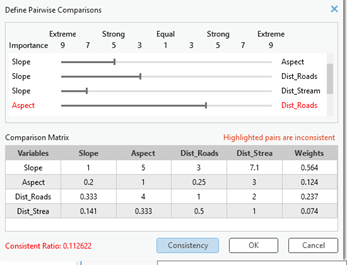
Since the ratio is greater than 0.1, the model is inconsistent. The ratio turns red and the three most inconsistent pairs are highlighted. As a result, the evaluations for the highlighted inconsistent pairs need to be adjusted (to see the other two highlighted pairs, you must scroll down in the slider list). Move the slider to 3 for the Aspect and Dist_Roads pair and recalculate the ratio.
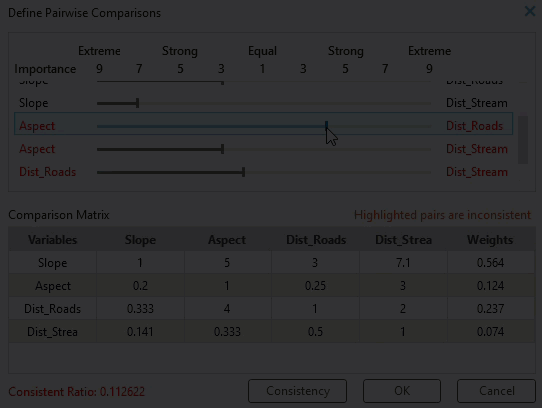
The ratio is now below 0.1 so the model is consistent.
The resulting weights can be entered as the weights in the above Suitability Modeler model. In the Assign Weights by Pairwise Comparison tool, the weights are calculated as decimals summing to 1. Before entering them as the weights into the Suitability Modeler model, they are multiplied by 100 to convert the values into percents.
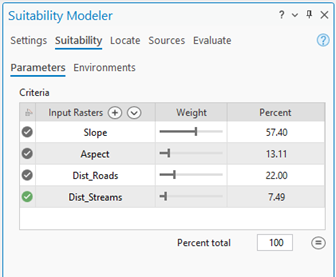
The Assign Weight by Pairwise Comparison tool was created as a stand-alone tool in the Analysis toolbox and is available with the Basic ArcGIS license. The resulting weights can be used in any suitability model created in ModelBuilder, in the Suitability Modeler in Spatial Analyst, and in Business Analyst. The weights can also be used when creating composite indices in Spatial Statistics.
The pairwise methodology can be more intuitive to implement and allows you to more accurately compare pairs of variables relative to one another, which means the final calculated weights are more objective and defensible.
For additional information, see How Assign Weights by Pairwise Comparison works.
References:
Saaty, T. L. 2008. “Decision making with the analytic hierarchy process”. International Journal of Services Sciences, 1(1), 83-98.


Very interesting blog and quite timely for me, so I read with much interest. You hit the nail on the head with regards to the problem of creating sensible weights, something I’m not particularly familiar with. But as I read your description I felt I have either found an error in your text or I have misunderstood what you describe. You say above:
Wouldn’t it be inconsistent if C is greater than A? As I see it you have described A > B > C?
On this page they say C cannot be greater than A. Which is what I would have understood as being inconsistent.